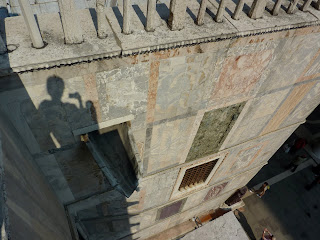 The Piazza San Marco, at the center of Venice, is a complicated and wonderful space: history built on history; structures gilded and decorated; religious and civic and hedonistic functions competing for space in this compressed city space.
The Piazza San Marco, at the center of Venice, is a complicated and wonderful space: history built on history; structures gilded and decorated; religious and civic and hedonistic functions competing for space in this compressed city space. One edge, to the right on this picture of the basilica of San Marco, struck me as especially complex. It is called the "piazzetta," the little piazza, and it stretches from the basilica to the waterfront in the long direction, and from the Palace of the Doges (the dukes) to the Biblioteca (library) Nazionale Marciana on the short side.
One edge, to the right on this picture of the basilica of San Marco, struck me as especially complex. It is called the "piazzetta," the little piazza, and it stretches from the basilica to the waterfront in the long direction, and from the Palace of the Doges (the dukes) to the Biblioteca (library) Nazionale Marciana on the short side. Here's where travelers to Venice in old times would have gotten out of their galleys and entered the city. They would have seen on their right the Duke's Palace (here on the left of the picture) -- a long marbled and pillared building speaking worlds about the power of the republic and its oligarchy.
Then at the end of the square, they would have seen the side of the basilica: again, covered in marble, laden with the spoils of Constantinople, a brilliant facade to the voluminous chiaroscuro of gleaming and dark inside.
And on their left as they made their way to the basilica, the Renaissance arcades of what is now the library -- and was even then, a storehouse of Greek and Latin humanism. (see my former posts on this blog)
 What I wonder, is whether the architects of this space imagined the other component to this mix of civic, religious, scholarly treasures? That is, the entertainment that fills it today -- and has at least since the 18th century. We know that because Canaletto's sparkling pictures show us people having a great time in this tourist town, which has been a tourist town longer than we can imagine.
What I wonder, is whether the architects of this space imagined the other component to this mix of civic, religious, scholarly treasures? That is, the entertainment that fills it today -- and has at least since the 18th century. We know that because Canaletto's sparkling pictures show us people having a great time in this tourist town, which has been a tourist town longer than we can imagine. After hearing mass and choral music in San Marco, we came out to the square, and what? brilliance after darkness, joviality after solemnity, schmaltz after Gounod's sanctus and Franck's Panis angelicus:
